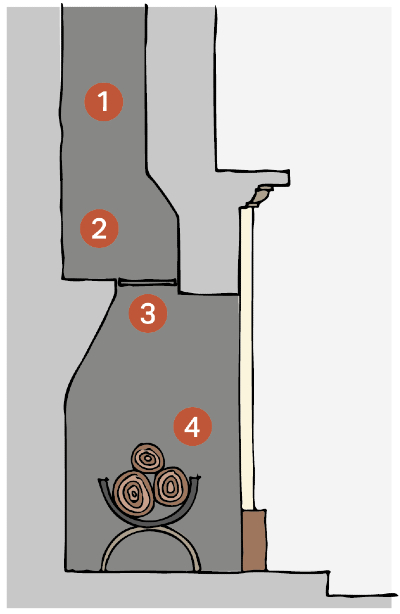
1. The existing flue remains unaltered and capable of functioning normally when the register plate is opened.
2. A register plate will need regular cleaning as soot, nesting material, and other debris can accumulate on the upper surface and this may present a fire hazard if left.
3. A register plate is normally made of steel, set within a simple frame. The frame is mechanically secured to the masonry of the chimney and its perimeter is usually sealed with fire cement or a rope gasket to produce a close fit. An opening flap-door allows smoke to pass when the flue is in use and can be adjusted to provide different degrees of ventilation at other times.
4. The open fireplace can remain as a feature in the room and without needing to be permanently closed it can easily be used when required.
A register plate is fire proof structure which is fitted in the lower part of a chimney and physically closes the flue to prevent draughts.
Many fireplaces in 19th and 20th century properties will already have integral chimney plates installed.
Unlike a chimney balloon, a register plate can remain in-situ when the fire is in use. A flap door contained in the plate is simply opened to allow smoke to escape when required. With a stay fitted, this flap door can also be adjusted to open varying degrees to aid ventilation as required.
In addition to use with open fires, a register plate may also be required where log burners, multi-fuel stoves, and other biomass burners are inserted into an existing fireplace.
A register plate would normally be constructed of metal and specially fabricated to suit the size and shape of the particular flue.
For safety reasons advice should be sought from a suitably qualified person before inserting any structure that restricts the size of an operable flue. A registered member of HETAS or the National Association of Chimney Sweeps (NACS) maybe able to help.
As much as 80% of the heat from a room can pass through a chimney flue. The insertion of a register plate will greatly reduce this figure.
By being adjustable a register plate can be effective year round. Simply open or close to control heat loss, draughts, and ventilation.
As a register plate is made to measure and requires permanent fitting, a little more work is required than for DIY measures.
The cost will vary with the size and complexity of the flue, but atypical flue will cost between £250 and £500.
Listed Building Consent is not required for chimney register plates.
We support the careful installation of chimney register plates where there is no detrimental impact on the special architectural or historic interest of the building, and where they are installed by a suitably qualified professional.
In the light of the Climate Emergency, we will generally permit and encourage alterations on listed buildings, with special regard to the the following:
- Preserving the building, its setting or any features of special architectural or historic interest which it possesses
- Preserving or enhancing the character of a conservation area
- Respecting the significance of any non-designated heritage asset
Energy Efficiency and Historic Buildings: Open Fires, Chimneys and Flues from Historic England
